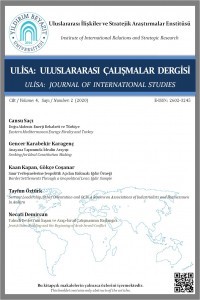Çin'in Proaktif Küresel Ekonomik Düzendeki Dönüşü Aşma Stratejisi: Kuşak ve Yol Girişimi'ni Küreselleşme ve Bölgeselleşme Trendleri Arasına Oturtmak
Kuşak ve Yol Girişimi, Küreselleşme, ters Küreselleşme, Bölgeselleşme, Ekonomik Entegrasyon, Çin Uluslararsı Siyaseti
China’s Proactive Strategy to Breach the Turn in Global Economic Order: Placing the Belt and Road Initiative in between Globalization and Regionalization Trends
Belt and Road Initiative, Globalization, de-globalization, Regionalization, Economic Integration, Chinese International Politics,
___
- Alon, I., Zhang, W., & Lattemann, C. (2018). Introduction. In W. Zhang, I. Alon, & C. Lattemann (Eds.), China’s Belt and Road Initiative: Changing the Rules of Globalization (pp. 1–13). Springer International Publishing. https://doi.org/10.1007/978-3-319-75435-2_1
- Andornino, G. B. (2017). The Belt and Road Initiative in China’s Emerging Grand Strategy of Connective Leadership. China and World Economy, 25(5), 4–22. https://doi.org/10.1111/cwe.12211
- Aoyama, R. (2016). “One Belt, One Road”: China’s New Global Strategy. Journal of Contemporary East Asia Studies, 5(2), 3–22. https://doi.org/10.1080/24761028.2016.11869094
- Baldwin, R., & Martin, P. (1999). Two Waves of Globalization: Superficial Similarities, Fundamental Differences. In Globalization and Labor (No. 6904). http://www.nber.org/papers/w6904
- Cai, K. G. (2018). The One Belt One Road and the Asian Infrastructure Investment Bank: Beijing’s New Strategy of Geoeconomics and Geopolitics. Journal of Contemporary China, 27(114), 831–847. https://doi.org/10.1080/10670564.2018.1488101
- Enderwick, P., & Buckley, P. J. (2020). Rising regionalization: will the post-COVID-19 world see a retreat from globalization? Transnational Corporations, 27(2), 99–112. https://doi.org/10.18356/8008753a-en
- Ferguson, N., & Schularick, M. (2007). ‘Chimerica’ and the Global Asset Market Boom. International Finance, 10(3), 215–239. https://doi.org/10.1111/j.1468-2362.2007.00210.x
- Gao, M. H. (2018). Globalization 5.0 Led by China: Powered by Positive Frames for BRI. In China’s Belt and Road Initiative: Changing the Rules of Globalization (pp. 321–335). Springer International Publishing. https://doi.org/10.1007/978-3-319-75435-2_17
- Gul, S., Umer, S., & Malik, M. S. (2018). China’s Belt and Road Initiative (BRI): Debt Quagmire or a Ridge Rope for Struggling Economies. Global Economics Review, III(I), 62–70. https://doi.org/10.31703/ger.2018(III-I).07
- He, Y. (2017). China’s new role in global governance: Shaping the emerging world order. China Quarterly of International Strategic Studies, 3(3), 341–355. https://doi.org/10.1142/S2377740017500221
- Holslag, J. (2017). How China’s New Silk Road Threatens European Trade. The International Spectator, 52(1), 46–60. https://doi.org/10.1080/03932729.2017.1261517
- Hui, Z., Qiangming, Y., & Li, N. (2021). BRI Infrastructure Development and Economic Growth. China Economist, 16(3), 26–61. https://doi.org/10.19602/j.chinaeconomist.2021.05.02
- Jones, H. (2010). CHINAMERICA: The Uneasy Partnership that Will Change the World. McGrawHill.
- KWAN, C. H. (2013). Trade Structure of China Becoming More Sophisticated: Changing complementary and competitive relationships with other countries. RIETI. https://www.rieti.go.jp/en/china/13060502.html
- Liu, Q. (2020). China’s One Belt One Road Initiative—A Debt Trap? [University of Denver]. https://www.proquest.com/docview/2447505702?pq-origsite=gscholar&fromopenview=true
- Liu, W., & Dunford, M. (2016). Inclusive globalization: unpacking China’s Belt and Road Initiative. Area Development and Policy, 1(3), 323–340. https://doi.org/10.1080/23792949.2016.1232598
- Livesey, F. (2018). Unpacking the possibilities of deglobalisation. Cambridge Journal of Regions, Economy and Society, 11(1), 177–187. https://doi.org/10.1093/cjres/rsx030
- Mehanna, R.-A. (2008). Globalization Versus Regionalization: And the Winner Is…. Journal of Transnational Management, 13(4), 287–317. https://doi.org/10.1080/15475770802574485
- NDRC. (2015). Vision And Actions On Jointly Building Silk Road Economic Belt And 21st-Century Maritime Silk Road. Belt and Road Portal. https://eng.yidaiyilu.gov.cn/qwyw/qwfb/1084.htm
- O’Sullivan, M. (2019). The Levelling: What’s Next After Globalization. PublicAffairs.
- Pisani-Ferry, J. (2021). The End of Globalization as We Know It. Project Syndicate. https://www.project-syndicate.org/commentary/future-of-globalization-national-priorities-international-threats-by-jean-pisani-ferry-2021-06
- Rajah, R. (2020). Roland Rajah (No. 1; Issue 2019). https://www.lowyinstitute.org/sites/default/files/East Asia%27s Decoupling_1.pdf
- Rodrik, D. (2011). The Globalization Paradox: Democracy and the Future of the World Economy. W. W. Norton.
- Rodrik, D. (2019). Globalization’s Wrong Turn and How it Hurt America. Foreign Affairs, 98(4).
- Rolland, N. (2017). China’s “Belt and Road Initiative”: Underwhelming or Game-Changer? The Washington Quarterly, 40(1), 127–142. https://doi.org/10.1080/0163660X.2017.1302743
- Sukar, A., & Ahmed, S. (2019). Rise of trade protectionism: the case of US-Sino trade war. Transnational Corporations Review, 11(4), 279–289. https://doi.org/10.1080/19186444.2019.1684133
- Therborn, G. (2000). Globalizations: Dimensions, Historical Waves, Regional Effects, Normative Governance. International Sociology, 15(2), 151–179. https://doi.org/10.1177/0268580900015002002
- Wade, R. H. (2004). Is globalization reducing poverty and inequality? World Development, 32(4), 567–589. https://doi.org/10.1016/j.worlddev.2003.10.007
- Wang, Z., & Sun, Z. (2021). From Globalization to Regionalization: The United States, China, and the Post-Covid-19 World Economic Order. Journal of Chinese Political Science, 26(1), 69–87. https://doi.org/10.1007/s11366-020-09706-3
- Wei, S.-J., & Frankel, J. A. (1996). Can regional blocs be a stepping stone to global free trade? a political economy analysis. International Review of Economics & Finance, 5(4), 339–347. https://doi.org/10.1016/S1059-0560(96)90021-0
- Witt, M. A. (2019). De-globalization: Theories, predictions, and opportunities for international business research. Journal of International Business Studies, 50(7), 1053–1077. https://doi.org/10.1057/s41267-019-00219-7
- World Bank. (2019). Belt and Road Economics: Opportunities and Risks of Transport Corridors. Washington, DC: World Bank. https://doi.org/10.1596/978-1-4648-1392-4
- Yilmaz, S., & Li, B. (2020). The BRI-Led Globalization and Its Implications for East Asian Regionalization. Chinese Political Science Review, 5(3), 395–416. https://doi.org/10.1007/s41111-020-00145-2
- Başlangıç: 2017
- Yayıncı: Ankara Yıldırım Beyazıt Üniversitesi
Barış İnşası ve Eğitim: Çatışma Sonrası Bosna Hersek’te Eğitim Reformu
Jahidul Islam SARKER, Tariquil ISLAM, Md Nazmul ISLAM, Moshiur RAHMAN
Türkiye-ABD İlişkileri (2016-2020): Asimetrik İttifakın Dönüşümü
Yeni Sınır Güvenliği Anlayışında Yapay Zekâ Yönetişimi: Fırsatlar ve Tehditler
